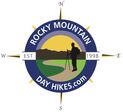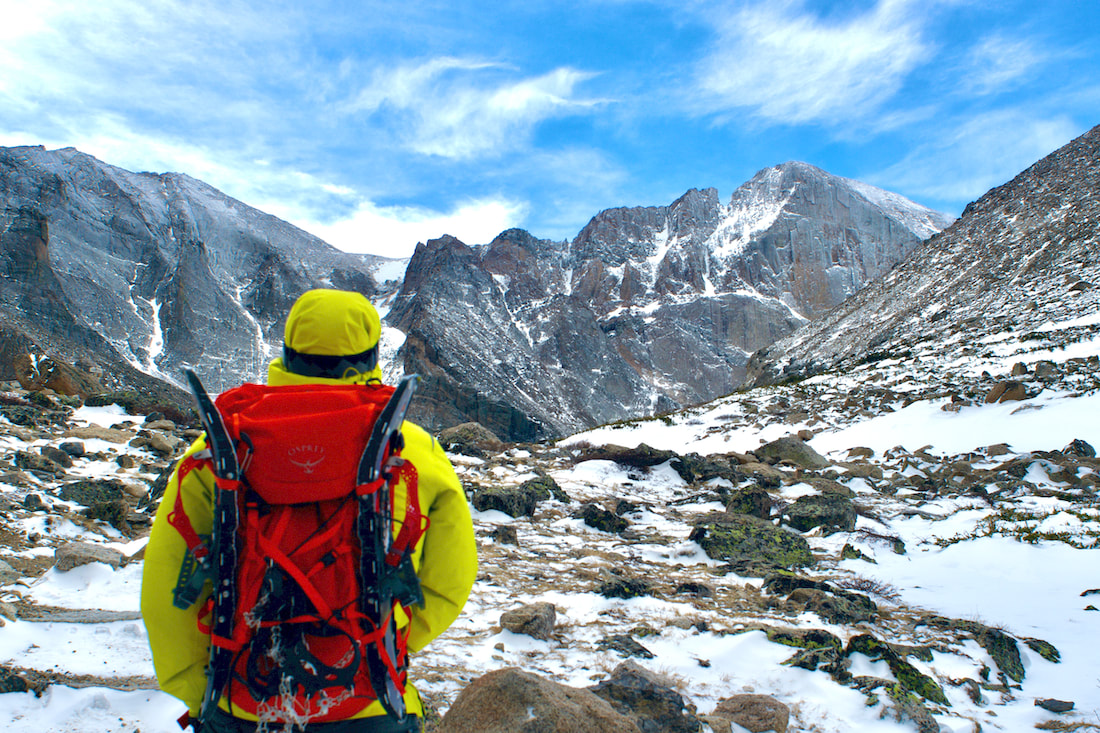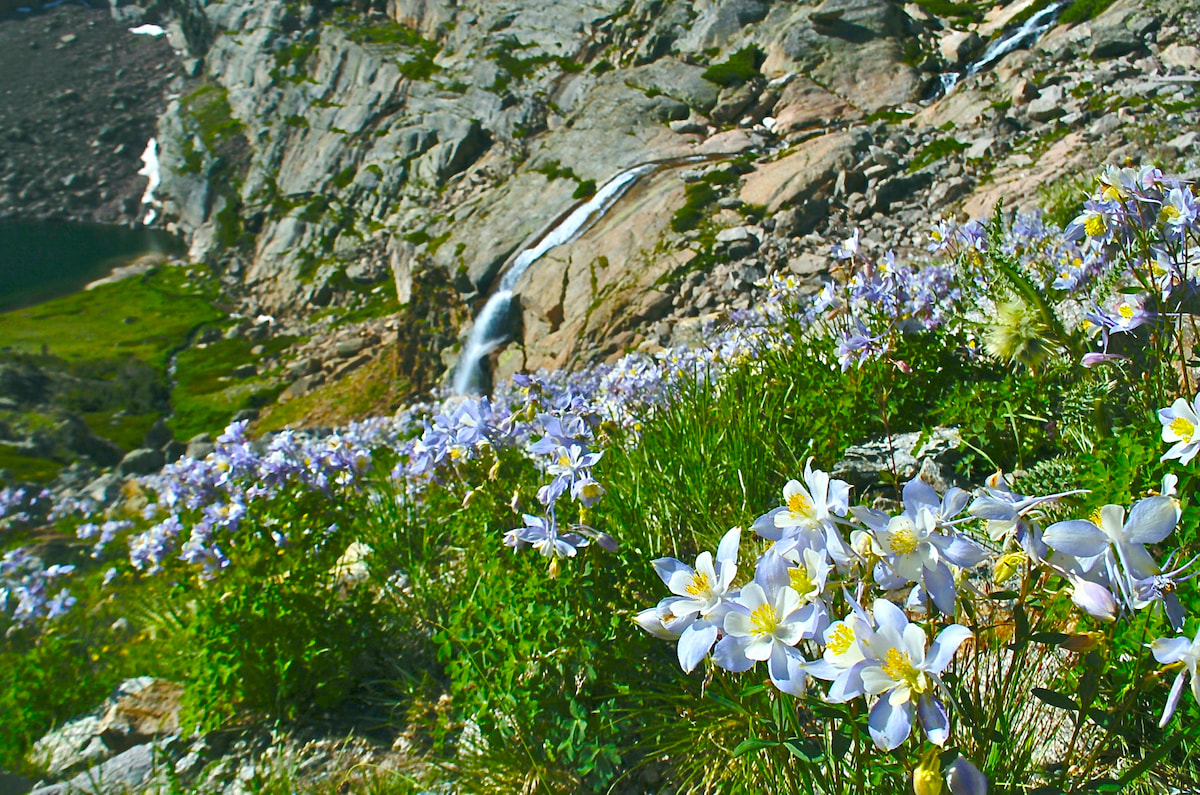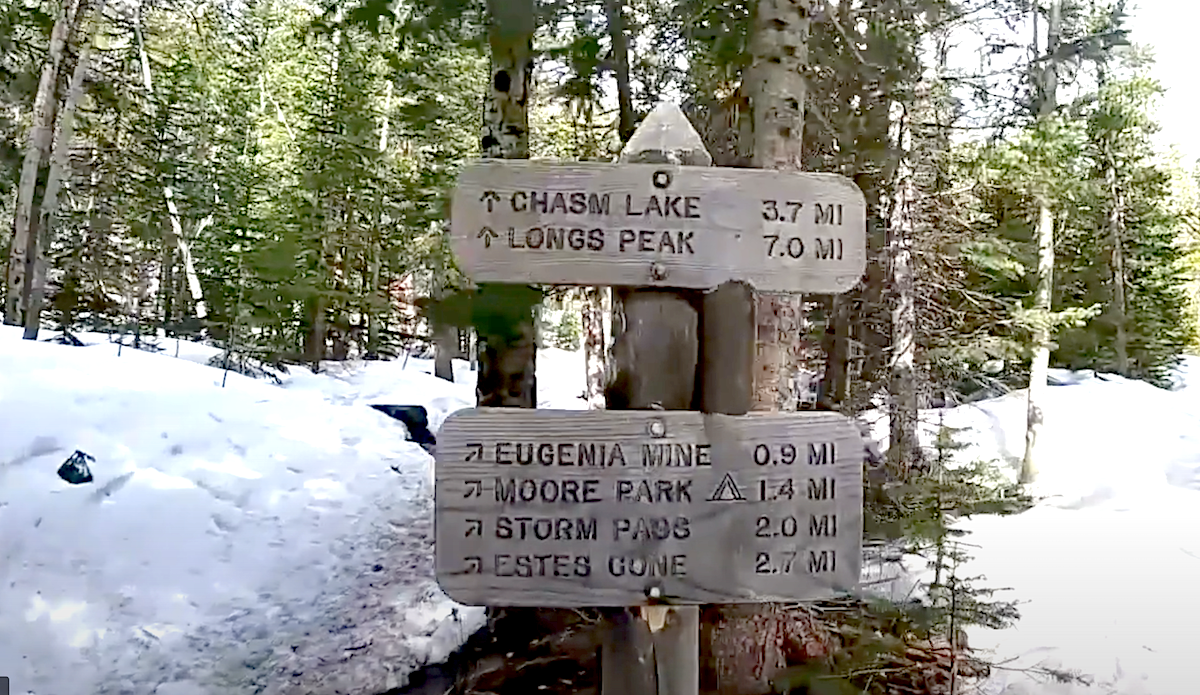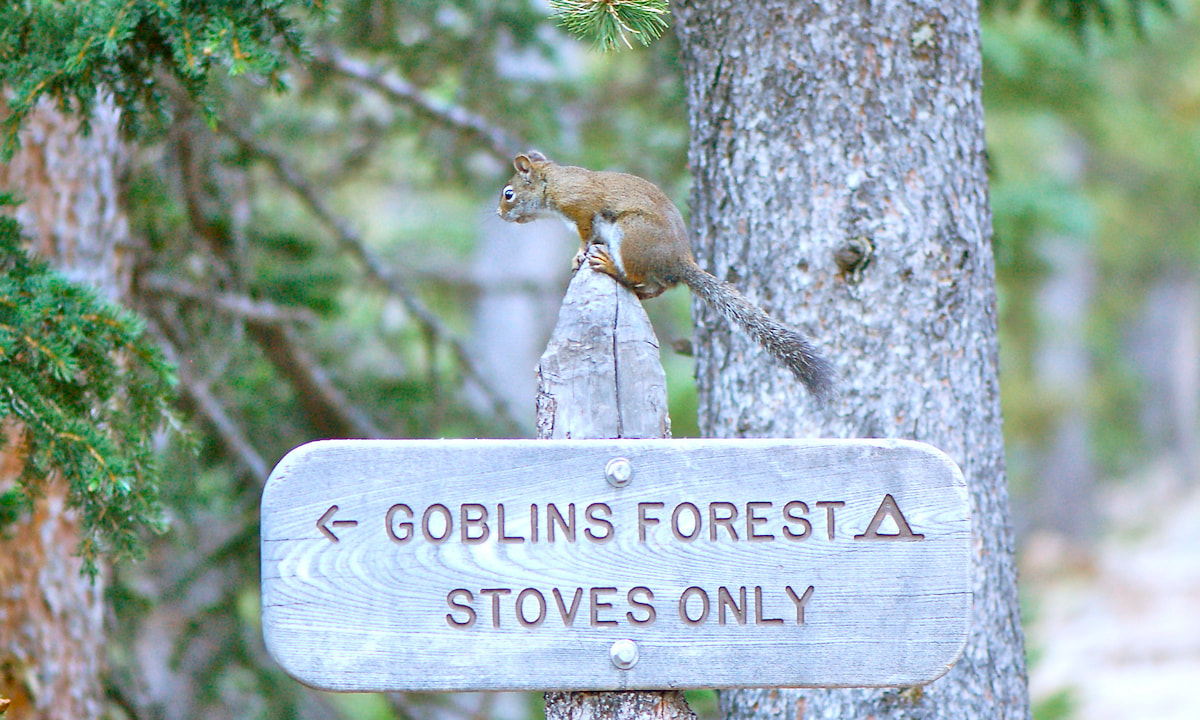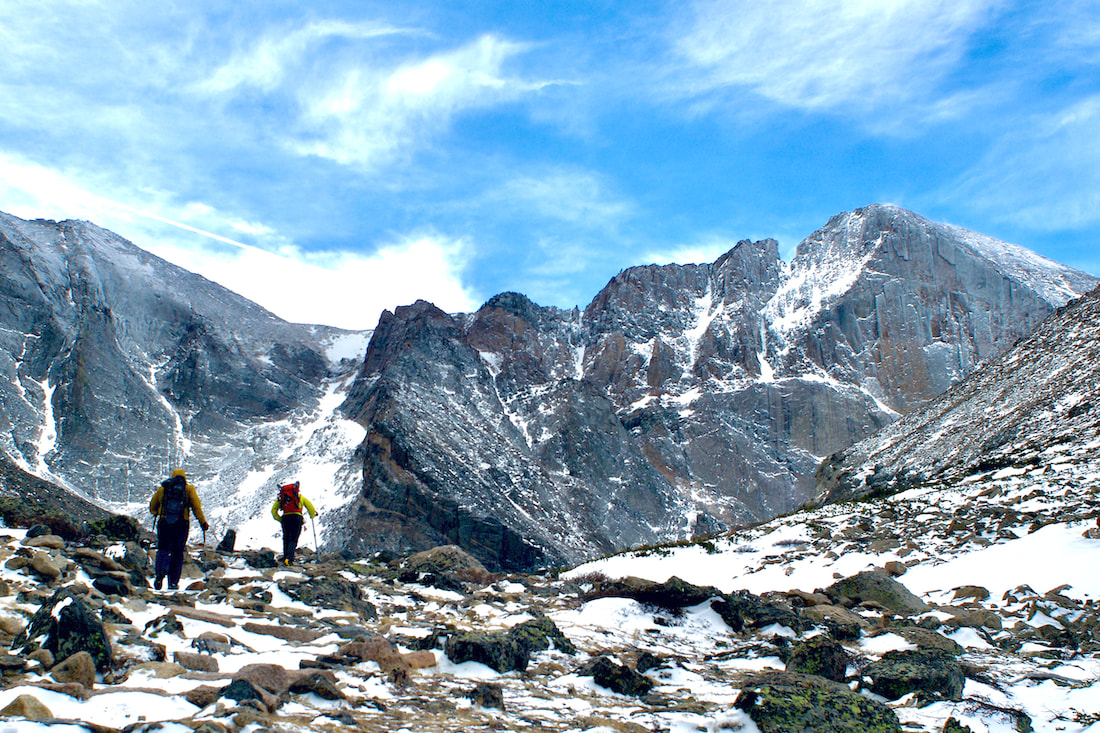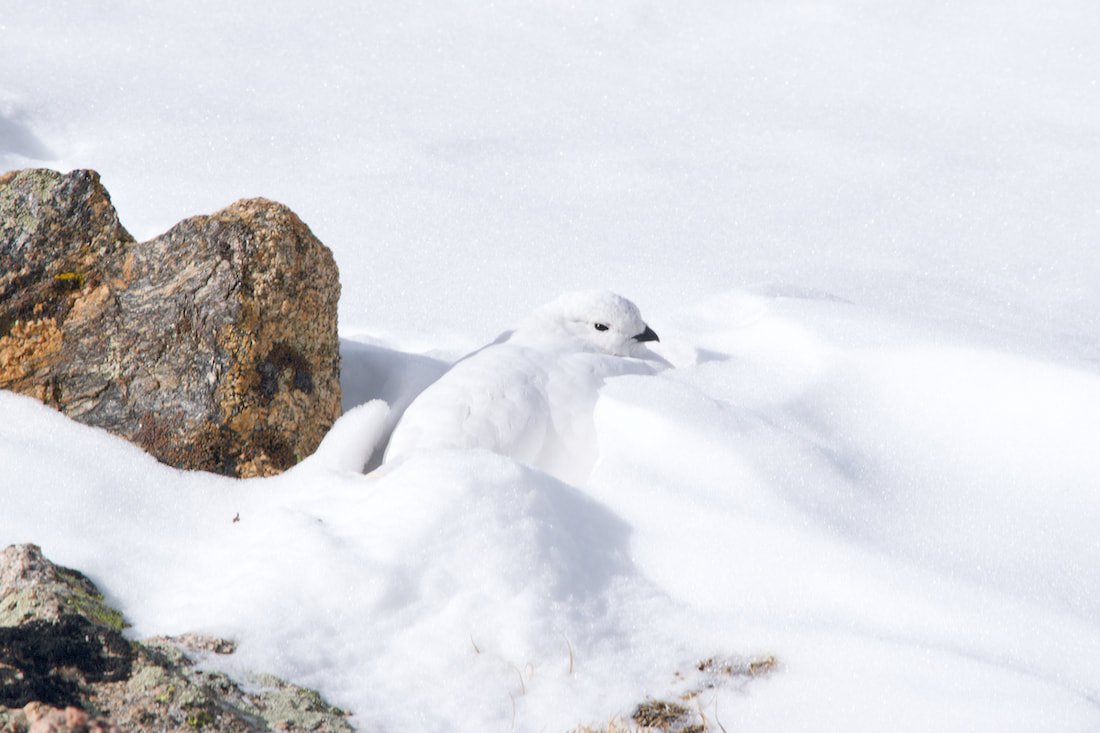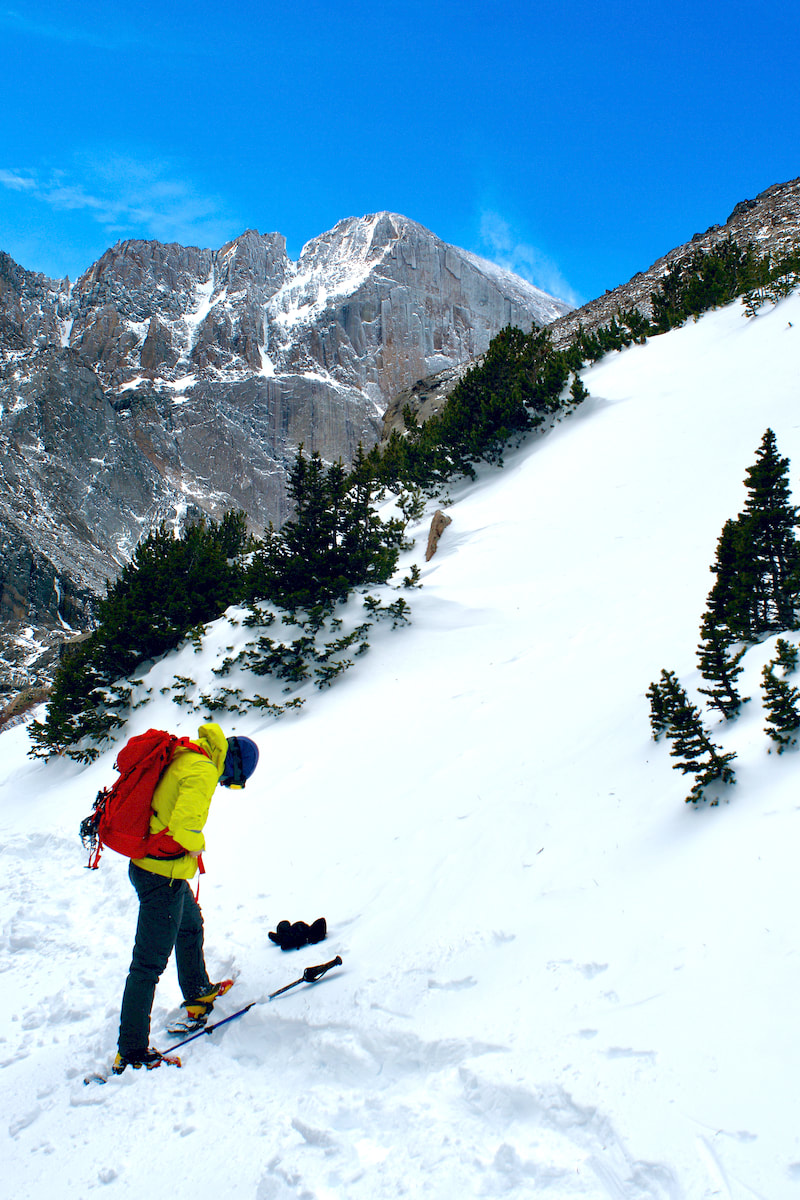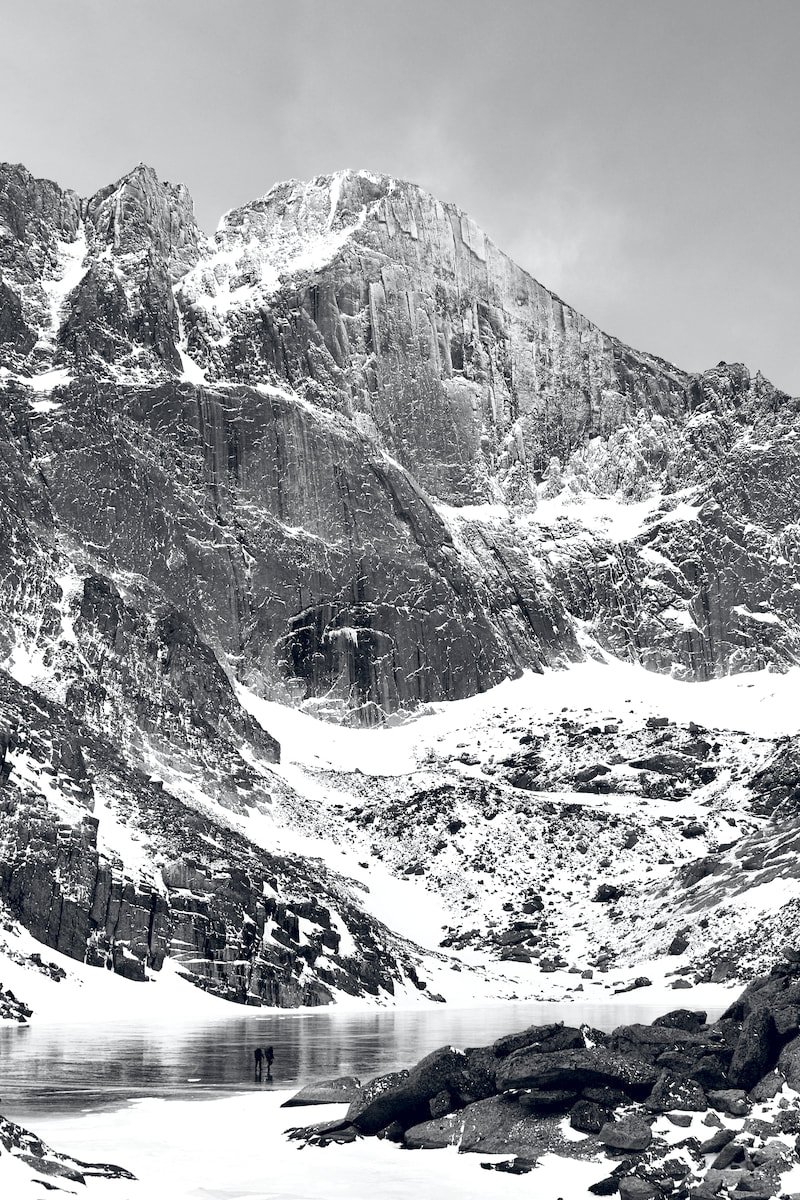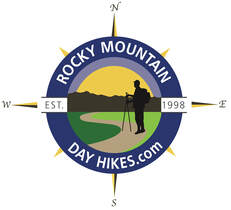|
Notes from the
Trail |
|
This winter, why not try a trek to a Rocky Mountain National Park classic, Chasm Lake.
It is important to pay attention to the conditions, namely the weather. Besides looking for a sunny day, check the winter weather for the wind forecast; strong winds and blowing snow create hazardous conditions. When winter trekking on this trail, plan to bring both snowshoes and good traction devices like spikes, and pay special attention to winter wear. When deciding your winter wear, if it’s a good weather day, the conditions could be anything from almost balmy to bitter cold in the shade. Be prepared to layer up or down. If, for whatever reason, you have decided to go up on a nasty day, goggles are a must. But do check the weather the night before. The Trail Out of the car, you are at the Longs Peak trailhead with a beginning elevation of 9,400’. The lake from here is 4.2 miles away and 2,360’ higher. The trail begins in smaller lodge pole pine, the pines are not as tall here because of the higher elevation. Although it is also possible that the area could have been logged during the time of the Enos Mills Longs Peak Inn era of the early 1900’s, and so they may not be that old either. The January trail is likely to be completely snow covered and snowshoes work best for this first part in the trees, although depending on how long it’s been since it snowed, you might find the trial is packed enough that snowshoes are not necessary. 'Tis better to carry them and not need them than to not carry them and wished you had. It's also better to wear them than to post hole and wreck the trail.
Shortly after that, the trail switchbacks at about a 140 degree angle to the south and you begin to steadily gain elevation. You are rewarded at the end of that traverse with a switchback at Alpine Brook, a nice little babbling brook in spruce and probably why the trail goes to this point. It makes for a pleasant early resting spot, even in winter.
Not long after, the trail turns left crossing tiny Larkspur Creek and begins a traverse up and across an east facing slope, so there are more spruce now. Four switchbacks more continues to gain elevation before crossing one more notable bridge at Alpine Brook. At this point, you are traveling through the treeline transition zone, an elevation above which no trees grow, about 11,000’. Isabella Bird wrote upon entering the Estes Valley that, “The scenery is the most glorious I have ever seen, and is above us, around us, at the very door.” So it is as you enter into the open alpine zone and Longs Peak comes into view. Here you will find an entirely different looking landscape than the one you just walked out of, and potentially an entirely different weather situation in the winter. From here, the lake sits another 797’ higher, and the trail is all in open, exposed alpine terrain. Consider the weather from this point on. During the winter months, the summer trail in this open area can be difficult to follow due to the trail being covered over with blowing snow. Even the winter trails made by previous snowshoers can get covered over easily and you may find yourself having to make your way as best you can picking up the trail when it becomes is visible. Because this stretch can be sketchy with the wind blowing the snow off in most areas, while accumulating in other areas, switching over from snowshoes to spikes can make the travel go easier. Also, make sure your wind jacket is handy if you have not put it on yet.
“When I woke, the moon was high shining through the silvery branches, whitening the bald Peak above, and glittering on the great abyss of snow behind, and pine logs were blazing like a bonfire in the cold still air. My feet were icy cold that I could not sleep again, and getting some blankets to sit in, and making a roll of them for my back, I sat for two-hours by the campfire. It was weird and gloriously beautiful.” You will be traveling in a west to south west direction, steadily gaining elevation as you go. You are looking for a saddle of sorts on the south ridge of Mt Lady Washington up ahead. Once reaching that low spot on the ridge, you will find a trail sign indicating a trail branching off to the right, leading towards Granite Pass for Longs Peak and traversing the north eastern side of Mt. Lady Washington. However, our trail at this point starts across and under the south east ridge to begin the last third of your hike. Snow accumulates along this next stretch of trail. Snow blows over the ridge you are now trekking under and settles, creating a snowfield that can last clear into June. Thus, the snow that falls here can be wind protected and softer, allowing for White-tailed Ptarmigan to nestle into the hillside among the rocks. Besides being somewhat wind protected, there are many days of sun along here and you might notice them sunning while nestling. But they can be amazingly difficult to see. You may see one at first, but then as you stare at it, you might notice a few more black eyes blinking at you. They might also be sitting on willow branches that they can poke their beaks down to and nibble on. According to the Rocky NPS website, they predominantly eat buds, leaves, and seeds, and are highly dependent on willow, especially in the winter. "They have been known, like other members of this group, to swallow grit to help grind coarse food in their gizzards. White-tailed Ptarmigans are permanent residents and lead a very sedentary lifestyle in winter. Warm weather may stress the White-tailed Ptarmigan. It can be seen bathing in snow when the temperature is higher than 21° C (70° F)." Rocky NPS
After a couple of tricky spots on this snowfield, you finish the traverse and cross onto an open flat alpine meadow, a large ledge left long ago by glacial retreat. The water from Chasm Lake, still higher up and not in sight, travels through this narrow spot before waterfalling down to Peacock Pool below. You will have to find a way across this very short stretch of frozen water, which can be polished and quite slick. But soon enough you are onto the open flat area and looking up at the looming cliff walls that is The Ships Prow emerging between Meeker Mtn and Longs. Searching for the final way up to the Lake, the direction to head is south, across the meadow. The trail here is often blown clear and easy enough to follow. It will take you to the base of a rocky area. Carefully work your way up. And then finally the frozen Chasm Lake. Unless you happen to come up not long after a snow fall and before any wind, the lake will be clear of snow. There are very large rock areas all over along the eastern edge of the lake that are enjoyable to hang out on in the summer, but you could be greeted with a cold steady breeze during the winter. Also, the sun sets behind Longs very early in the day this time of year and once that sun is gone, the temps can drop quickly. Sometimes sunny pockets protected from wind can be found among the rocks to re-hydrate and re-nourish before making the return trek. It can also be a good spot to pull out a thermous of something warm to drink or even fire up a small cook stove to heat up water for soup. Because once are here, you have made it, and it is worth clinking your water bottle with the rocks to celebrate this place. This amazing place. This weird and gloriously beautiful place.
2 Comments
Robert Hostetler
2/25/2025 01:58:42 pm
We enjoyed your article on a Chasm Lake hike in winter. Have you ever considered going way beyond that hike in winter in the area? At 83, I may not make it to Chasm in winter anymore but over the years I've done many hikes and climbs in the area.in winter, including a number of solo ascents of Longs via The Trough from Black Lake which I think is the safest route to the summer by far in winter.. Let me know if you want any beta on those possibilities.
Reply
Dave
3/4/2025 10:38:02 am
Glad you enjoyed the article. There are indeed a great many ways to tackle winter in Rocky! I have not tried the Trough from Black Lake, but have looked at it and know people who have. Feel free to email me at [email protected]. Thanks!
Reply
Leave a Reply. |
"The wild requires that we learn the terrain, nod to all the plants and animals and birds, ford the streams and cross the ridges, and tell a good story when we get back home." ~ Gary Snyder
Categories
All
“Hiking -I don’t like either the word or the thing. People ought to saunter in the mountains - not hike! Do you know the origin of the word ‘saunter?’ It’s a beautiful word. Away back in the Middle Ages people used to go on pilgrimages to the Holy Land, and when people in the villages through which they passed asked where they were going, they would reply, A la sainte terre,’ ‘To the Holy Land.’ And so they became known as sainte-terre-ers or saunterers. Now these mountains are our Holy Land, and we ought to saunter through them reverently, not ‘hike’ through them.” ~ John Muir |
© Copyright 2025 Barefoot Publications, All Rights Reserved
